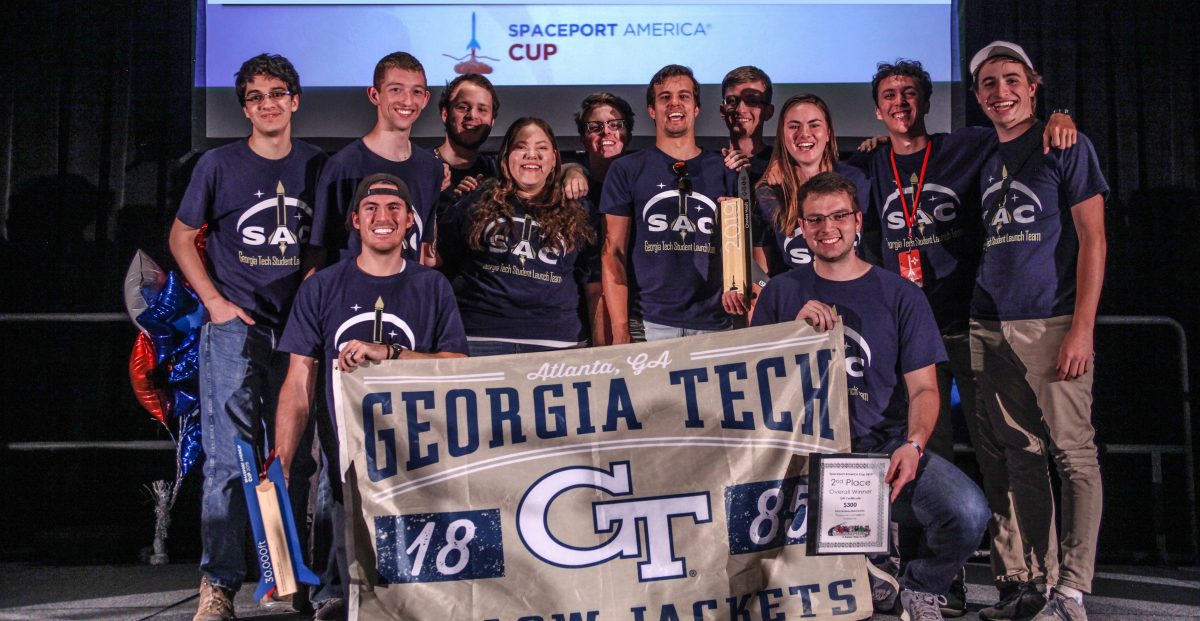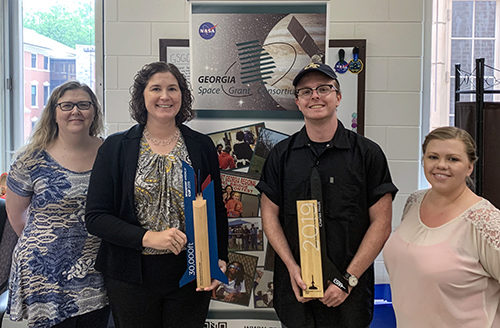 Celebrating for Everyone. More than 20 students (mostly from the AE School) contributed to the design, build, and flight of Sustain Alive; only 14 could attend the final SAC competition in New Mexico. Celebrating the team's win for everyone are, back row, from left: Taha Krarti, Nicholas Brophy, Austin Lee, Brenda Valdez, Carson Coursey, Dan Fries, Benjamin Jensrud, Rachel Thomas, Carson Dobbs, Sawyer Flanagan. Front row: Matthew Chicky, Robert "Casey" Wilson. Check out this video diary of the Team's yearlong efforts.
Celebrating for Everyone. More than 20 students (mostly from the AE School) contributed to the design, build, and flight of Sustain Alive; only 14 could attend the final SAC competition in New Mexico. Celebrating the team's win for everyone are, back row, from left: Taha Krarti, Nicholas Brophy, Austin Lee, Brenda Valdez, Carson Coursey, Dan Fries, Benjamin Jensrud, Rachel Thomas, Carson Dobbs, Sawyer Flanagan. Front row: Matthew Chicky, Robert "Casey" Wilson. Check out this video diary of the Team's yearlong efforts.
Sustain Alive - a 13.5-foot, 110-pound rocket designed and built mainly by undergrads from the Daniel Guggenheim School of Aerospace Engineering - soared above dozens of competitors to take home three top awards at the Third Annual Spaceport America Cup fly-off, held June 18-22 in Las Cruces, New Mexico.
 |
| This Is It. First-year AE students Carson Coursey, Taha Krarti, and Nicholas Brophy were among the 14 AE students from Team Sustain Alive who were able to make the final trip to the New Mexico fly-off. |
The Cup is a special competition for student rocketry teams from around the world. Teams are tasked with launching solid, liquid, and hybrid rockets to target altitudes of 10,000 and 30,000 feet.
Sustain Alive garnered the top prize in its category by ascending to an altitude of 28,140 feet before beginning its parachute-aided descent into the desert. The team also bested a field of 92 other teams by finishing second in the "Best Overall Submission" category. And, finally, Reliable Modeling and Experimental Validation of Staging Events for Model Rockets," (pdf) a paper authored by four team members, was tapped to receive the Charles Hoult Award for Modeling & Simulation.
"The best part of all of this is that this team is full of rising sophomores, so most of them will be coming back next year with a lot of experience and knowledge," said Robert "Casey" Wilson, who, along with fellow AE grad student Matt Chicky, mentored the first-year engineering students for the better part of a year. Wilson is currently interning at SpaceX in California, while Chicky, who earned his MS AE in May, works at Northrop Grumman in Utah.
Both men took time off from their work to travel to New Mexico for the final fly-off.
"Going into this competition, me and Matt thought that, well, it's a first-year rocket team, it could be disorganized or it could end up where he and I would be pulling everything together at the last moment," said Wilson.
 "But every single member of this team contributed significantly. I think it's a testament to the type of students that the AE School recruits. They're not in it for their resume. They were all dedicated to getting it right."
"But every single member of this team contributed significantly. I think it's a testament to the type of students that the AE School recruits. They're not in it for their resume. They were all dedicated to getting it right."
As per the competition rules, Sustain Alive was built using only commercial off-the-shelf (COTS) materials and its success was judged, in part, by how intact it was after landing.
"There's a computer onboard that registers when the engine stops firing and it measures the altitude to determine when to deploy the parachute," said Carson Coursey, a rising AE sophomore.
"If you deploy that parachute too early, you could cause the rocket to drift away from its target landing site. But if you deploy it too low, you could end up ripping the parachute or hitting the ground at a speed that will cause damage."
Organized under the auspices of the Ramblin Rocket Club, the 20+ students on Team Sustain Alive met after classes and on weekends for eight months to get their rocket prepped. There was no academic credit or huge prize to motivate them.
"I think the $450 prize that we won is all coupon codes to a rocket supply store," said Coursey. "Which is great, because we can use it for next year."
As the first-ever Georgia Tech submission to the Spaceport America Cup, Team Sustain Alive was laser focused on making a credible showing.
"When we got to New Mexico - some of us drove, others flew - we were all tired but excited. We probably spent 20 or 24 hours putting the rocket together again, and testing it, before the final flight," said Dan Fries, an AE doctoral student who joined Team Sustain Alive. "There was no squabbling or confusion about what we had to do. We had a lot of work to do on the ground, and, even if we were tired or hungry, we did it."
 |
| Trophies in Hand. Helping Carson Coursey to celebrate Sustain Alive's SAC win are reps from the Georgia Space Grant Consortium: Lori Skillings, Prof. Karen Feigh, and Alysia Watson |
Looking back, Wilson marveled at how well the whole enterprise went. Except for one thing:
"I couldn't have predicted how many students would be involved and how many would be willing to drop everything to come to the final competition in the middle of the desert in June," he said with a chuckle.
"So we kind of low-balled the transportation costs...not a bad problem to have."
The yearlong efforts of Team Sustain Alive - including transportation - were supported by contributions from the Daniel Guggenheim School of Aerospace Engineering, the Georgia Tech Student Government Association, the Georgia Space Grant Consortium, The Finley Family, Leonard Coleman, Ernie Marsh, Tony Alcocer, the GT-AE Machine Shop, the GT-AE Yang Aero Maker Space, and Pscolka Woodworks.
Interested in joining (or supporting) next year's team?
Contact gtspaceportamericacup@gmail.com
 Team Sustain Alive Celebrates Stayin' Alive at the Spaceport America Cup. From left, Sawyer Flanagan, Carson Dobbs, Shan Selvamurugan, Austin Lee, Brenda Valdez, Rachel Thomas, Casey Wilson, Matthew Chicky, Nicholas Brophy, Taha Krarti, Dan Fries, Vishnu Pulavarthi, Carson Coursey, Benjamin Jensrud. Not pictured: Blake Lathrop (ME), Austin Hatch, Coleman Pethel, Eduardo Sebastian, Michael Watanabe, Simon Pahlsmeyer, Mai Vo, Patrick Finley
Team Sustain Alive Celebrates Stayin' Alive at the Spaceport America Cup. From left, Sawyer Flanagan, Carson Dobbs, Shan Selvamurugan, Austin Lee, Brenda Valdez, Rachel Thomas, Casey Wilson, Matthew Chicky, Nicholas Brophy, Taha Krarti, Dan Fries, Vishnu Pulavarthi, Carson Coursey, Benjamin Jensrud. Not pictured: Blake Lathrop (ME), Austin Hatch, Coleman Pethel, Eduardo Sebastian, Michael Watanabe, Simon Pahlsmeyer, Mai Vo, Patrick Finley